Books for Kids with a Quirky Sense of Humor
The below list of books is certainly not for every child, but there are those with a certain sense of humor that love things that are a little offbeat or simply downright ridiculous. This is a list for those special children.
Many of the below titles have won the Irma Black Award. Presented annually by the Bank Street College of Education in New York City, the Irma Black Award is an award celebrating an outstanding picture book published the previous year. It is my favorite award given because it is one of the few awards voted on by children. This demonstrates that while the books below might appear to be silly or in some cases strange to adults, children seem to love them.
*This post contains affiliate links. To read my full disclosure CLICK HERE.
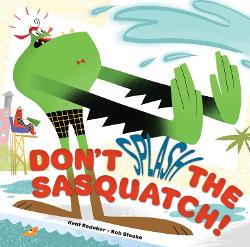 Don’t Splash the Sasquatch by Kent Redeker; illustrated by Bob Staake, 2016
Don’t Splash the Sasquatch by Kent Redeker; illustrated by Bob Staake, 2016
(Ages 3 – 6)
In this wet and wild read, kids will meet a variety of strange, but often funny characters. Sasquatch is spending the day at the pool, but does not want to get splashed in fear that his beautiful fur will get squizzlefied. Enter Miss Elephant Shark, Mr. Octo-Rhino, Miss Goat-Whale, and Miss Lock-Ness Monster-Space-Alien, all of whom splash the Sasquatch, of course. His fur gets squizzlefied and they work together to give him a new style….until they all jump in again, that is. This story is so silly and fun. It is not only enjoyable to listen to, but it is also entertaining to read as an adult. It is sure to illicit giggles from most children and hopefully inspire them to create their own strange and wacky creatures.
Bob Staake is a well-known children’s illustrator who has worked on over 65 books. His artwork is always very distinct and brings a certain whimsy to all of his stories.
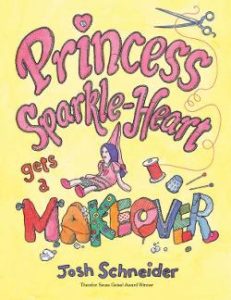 Princess Sparkle-Heart Gets a Makeover by Josh Schneieder, 2014
Princess Sparkle-Heart Gets a Makeover by Josh Schneieder, 2014
(Ages 4 – 8)
The story begins on the title page as we see Amelia playing with her dog and then receiving a new doll as a gift. The narrator states, “Amelia and Princess Sparkle-Heart were best friends”. Readers can infer that the angry dog growling and giving the stink eye to Princess Sparkle-Heart used to be Amelia’s best friend. With plenty of white space, the reader’s eye naturally gravitates toward the hilarious interactions between the characters. As Amelia enjoys many activities with her doll, we see the dog edging closer and closer to Princess Sparkle-Heart emitting a “Grrrrrrrrrrrrrrrrrrrr” the entire time. It is not long before Princess Sparkle-Heart has an “accident”. Josh Schneider perfectly captures Amelia’s anguish as she drops to her knees in sorrow. Luckily Amelia’s mother is up to the task of putting the poor doll back together with a few improvements. Amelia picks out new hair, teeth, and just the right outfit. Once the finishing touches are done, the dog tries to sneak up on his victim again, but is shocked to find that Princess Sparkle-Heart’s makeover has made her look terrifying. Luckily, the last page reveals Amelia, Princess Sparkle-Heart, and her dog all playing together providing a sweet ending.
I loved everything about this book. The illustrations made me smile from the beginning as we meet the exuberant Amelia with wild red hair, short overalls, and a skinned knee. Then the book made me laugh out loud at the end with a surprise reveal. I read this to a group of kindergartners and when the new doll is presented at the end, half the class looked at me in confusion and the other half erupted in laughter. Again, this book will not be for everyone, but since I tend to like off-the-cuff humor, I thought it was perfection.
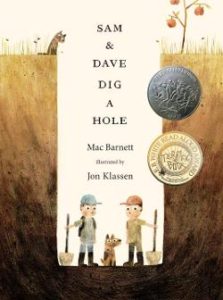 Sam and Dave Dig a Hole by Mac Barnett; illustrated by Jon Klassen, 2014
Sam and Dave Dig a Hole by Mac Barnett; illustrated by Jon Klassen, 2014
(Ages 4 to 8)
This book received many accolades, but I simply did not “get it” the first time I read it. It was a nominee for the Irma Black Awards and I could not believe the positive response I got from my first and second grade students when I read it out loud to them. They absolutely loved it!
Accompanied by their dog, Sam and Dave dig a hole in their backyard looking for treasure. As they dig, children can see the gems hidden in the soil that Sam and Dave miss. They often change directions and even split up, each time narrowly missing a gem stone that gets bigger and bigger as the story goes on. The students in my school thought this was absolutely hilarious and could not help but shout out to Sam and Dave that the gigantic gems were right next to them. In an odd twist, the explorers fall into white space and at first glance end up back at their home. Upon closer inspection, observant children will notice that Sam and Dave have actually arrived at a new location creating a great prompt for a discussion on where they are and how they got there.
Mac Barnett and Jon Klassen are a dynamic duo that have been highly successful with their picture book collaborations. Sam and Dave Dig a Hole won the 2015 Irma Black Award, a Caldecott Honor for outstanding illustrations, and the E.B. White Read Aloud Award.
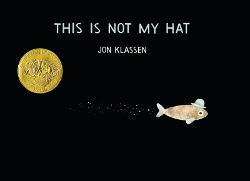 This Is Not My Hat by Jon Klassen, 2012
This Is Not My Hat by Jon Klassen, 2012
(Ages 4 to 8)
Jon Klassen is a very talented author and illustrator who is all the rage right now. He created a trilogy of “hat” books that are each a little off-kilter: I Want My Hat Back (2011), This is Not My Hat (2012), and We Found a Hat (2016). While all of these books could make this list, I chose to highlight This Is Not My Hat because it is my favorite and it won the Caldecott Medal in 2013 for the most outstanding illustrations of the year.
The story focuses on a tiny fish who claims that he stole a hat from a big fish. In a boastful tone, he explains why he stole the hat and how he plans to escape. Unbeknownst to the little fish, is that the larger fish, who owns the hat, wakes up and follows him.
I do a Caldecott unit with my Kindergarten students and this is my favorite Caldecott winner to show to them because it so clearly demonstrates one of the Caldecott’s criteria that the illustrations have to enhance the story. Since the story is so short, I read the book to my Kindergartners twice. Once I read it without showing the pictures and the second time I read it with the pictures. Seeing the illustrations completely changes the outcome of the story. If you don’t see the pictures, the reader assumes the little fish got away with stealing the hat, but the illustrations tell a different story. The illustrations contradict the text and it is this contradiction that children love.
There is one wordless spread of tall, dark sea grass where the reader has to infer that some action occurs that causes the big fish to get his hat back since the last image is of the larger fish sleeping with his hat back on his head. My students and I have a wonderful discussion on how the big fish got his hat back. Many students assume the big fish ate the little fish, but since there is not text or illustrations confirming that hypothesis, we don’t really know. Other students have guessed that maybe the big fish simply asked for the hat back or the little fish dropped it. I love that children can use their imaginations to speculate what happened behind that murky sea grass. This is a wonderful book to share one-on-one or use in a group setting.
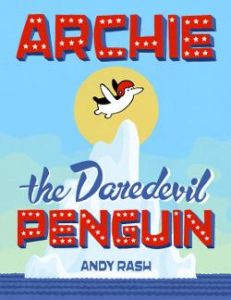 Archie the Daredevil Penguin by Andy Rash, 2015
Archie the Daredevil Penguin by Andy Rash, 2015
(Ages 4 to 8)
The other penguins think Archie and his inventions are quite daring, but they don’t know his terrible secret that he is “afraid of the water and the strange creatures who lurk in the briny deep.” When invited to a fish fry on a separate iceberg, Archie tries failed invention after failed invention to fly over the water and onto the iceberg. Each attempt is more comical than the next and in his last effort, his biggest fear comes true as he falls into the water. He comes face to face with the sea creatures he has feared for so long and discovers that they are more friendly than scary. They teach him how to swim, where he learns the joys of performing barrel rolls and loop-de-loops in the water. The story is presented in a colorful modified comic book format with amusing dialogue featured in speech bubbles. There is also a great use of onomatopoeia that creates fun sound effects for the reader such as “boing, whump, splash!” It is a fun story for budding inventors, anyone who has faced a fear, or children who just enjoy a fun offbeat story.
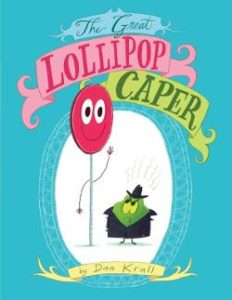 The Great Lollipop Caper by Dan Krall, 2013
The Great Lollipop Caper by Dan Krall, 2013
(Ages 4 – 8)
Children may have never heard of a caper, that tiny pickled, bitter green thing that lives in a jar, and that is exactly why Mr. Caper is angry. Mr. Caper is jealous that children all over the world love lollipops, but won’t even try capers. He devises an evil plan to make lollipops taste like capers, so that he will be loved instead. Of course, his plan backfires, but luckily there is a happy ending. This is a book that is often checked out from my library and is as much fun to read out loud as it is to listen to.
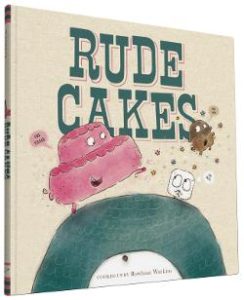 Rude Cakes by Rowboat Watkins, 2015
Rude Cakes by Rowboat Watkins, 2015
(Ages 4 – 8)
Who knew cakes could be so rude? In this hilarious tale about manners, a two-tiered pink cake is shown being quite impolite to his friends and parents. He never says please or thank you, he doesn’t take turns, and he sometimes even takes things that don’t belong to him. When he doesn’t listen to his parents and stays up late during bedtime, he suddenly gets plucked out of his bed by a giant cyclops. Just when the reader thinks the cake will be eaten, Watkins uses perfect comedic timing to explain that the cyclops has mistaken the cake for a jaunty, little hat. While the cake exhibits disrespectful behavior, the giant cyclops is the epitome of politeness. The cyclops says thank you, takes turns, and loves to share. When the cake finally uses the word, “please”, the cyclops listens and returns him to his bed. After observing the cyclops, we find that “of course, no cake is ever too rude to change” with the final spread showing the cake sharing his stuffed animal and balloons with friends. The kooky humor is the perfect way to provide a lesson in good manners without being preachy. A fun and valuable read!
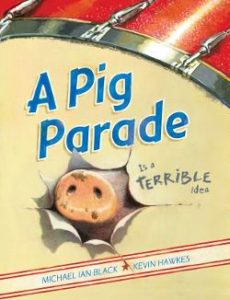 A Pig Parade is a Terrible Idea by Ian Michael Black; illustrated by Kevin Hawks, 2010
A Pig Parade is a Terrible Idea by Ian Michael Black; illustrated by Kevin Hawks, 2010
(Ages 4 to 8)
The hilarious deadpan narration paired with the highly amusing illustrations make this book a winner. The reader is first presented with cartoonlike illustrations of grinning pigs wearing majorette uniforms marching in a parade with the text, “Like most children, you have probably thought to yourself at one time or another, I bet a pig parade would be a lot of fun.” Then the story flashes to an image of a more realistic depiction of pigs wearing majorette uniforms that are too small and some of them even eating them reinforcing that a pig parade is a terrible idea. Again, the droll narration is spot on. “Perhaps they consider majorette uniforms unflattering. Nonsense. Everybody looks sharp in a majorette uniform, even pigs (especially pigs!). But when you try explaining that to them, they just look at you as if you are speaking a language they do not understand.” This was an Irma Black Award nominee that did not end up winning, but was still enjoyed by many children who like tongue-in-cheek humor.
 It’s Only Stanley by Jon Agee, 2015
It’s Only Stanley by Jon Agee, 2015
(Ages 6 -9)
Jon Agee has made a name for himself in children’s literature for creating several quirky and offbeat books. I read this book for the first time when it was nominated for the Irma Black Awards in 2016. It was another book that I didn’t really care for the first time around, but came to love it after reading it several times with my first and second grade students. The story takes place late one night when the Wimbledon family is fast asleep. Strange noises from their family dog, Stanley, continue to wake them throughout the night. The refrain of “It’s only Stanley” doing some odd activity around the house creates a misdirection for the reader of what Stanley is actually up to. In a shocking twist, Stanley has transformed the house into a rocket ship set to the moon to visit a pink moon dog.
My students enjoyed the rhyming text, funny sound effects, and the surprising development at the end of the book that makes this such a great read aloud. There are several visual clues highlighted in the illustrations that foreshadow what Stanley is really doing. After reading the book, some of my more observant students loved pointing out these details and wanted to read it again now knowing the secret. It was clearly a hit with children across the country as this book won the Irma Black Award in 2016.
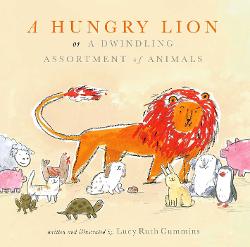 A Hungry Lion or A Dwindling Assortment of Animals by Lucy Ruth Cummins, 2016
A Hungry Lion or A Dwindling Assortment of Animals by Lucy Ruth Cummins, 2016
(Ages 6 – 9)
I originally read this book because it received several starred reviews and was highly recommended. After all the hype, I was very disappointed in the story and found it more disturbing than comical. Which is why I was not exactly thrilled when it was one of the nominees for the 2017 Irma Black awards. When I read it to my first and second graders, however, I found that while some of them did not “get it” the majority of the students thought the book was hilarious.
The narrator begins the story by listing a group of animals on a two-page spread, but has to start over on each subsequent page as the animals begin vanishing. The reader can infer that the hungry lion might be the cause of the animals’ disappearances, but we soon discover that the animals were actually exiting to set up for a surprise party for the lion. A bit shocking to me was that the lion then ate everyone! Then enters a fashionably late and ravenous T. Rex who eats the lion. The book ends with one unexpected lone survivor enjoying the cake from the party. Again, while I find this story to be a bit strange, many of the first and second graders in our school voted for the book for the Irma Black Awards resulting in a second-place win after The Night Gardener by the Fan Brothers.
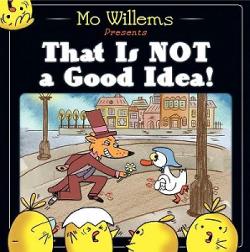 That is Not a Good Idea by Mo Willems, 2013
That is Not a Good Idea by Mo Willems, 2013
(Ages 6 to 9)
Willems makes a tribute to silent films in this surprising book. Similar to those beautiful old movies, Willems designed the book to show the interaction between a fox and duck on one page and the dialogue in white type on black background on another page. The first few spreads show a very dapper, villainous fox encountering a demure looking duck in the streets of an old-fashioned town. The text reads, “What luck! Dinner” making the reader assume the fox is going to try and trick the duck into becoming his meal. The next few pages show the fox asking the duck to accompany him into the deep dark woods and ultimately into his kitchen. Each time the duck responds positively, little yellow chicks pop up shouting “That is not a good idea!” This is a fun book to read out loud to a group because children usually love the suspense of this story and often chime in during the chicks’ refrain trying to warn the duck. They are often shocked at the surprise ending that almost always elicits a reaction from children. Adults may be equally as stunned and possibly a bit horrified at the ending, but children seem to love it. This was another unconventional book that won the Irma Black Awards in 2014.
 I Don’t Like Koala by Sean Ferrell; illustrated by Charles Santoso, 2015
I Don’t Like Koala by Sean Ferrell; illustrated by Charles Santoso, 2015
(Ages 6 -9)
This is one of those books that you will probably either love or hate. Adam receives a spooky looking koala stuffed animal as a present and it seems to follow him with his eyes everywhere he goes. Despite trying to dispose of Koala several different ways, he always seems to find his way back into his bed. One night Adam is in bed complaining about Koala when he is distracted by scary shadows. It is then that he realizes Koala’s watchful eyes are only there to protect him. In the final scene, Adam nestles down to sleep muttering, “I love Koala” while his parents look on from the doorway and his father delivers the funny punch line. “I don’t like Koala”. The illustrations really make this story. There is plenty of white space that allows the eye to rest on the koala, which really does look creepy. Some may find this story disturbing while others will think it is hilarious and the ending sweet.
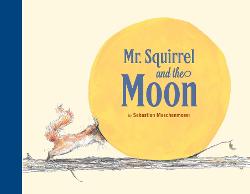 Mr. Squirrel and the Moon by Sebastian Meschenmoser, 2015
Mr. Squirrel and the Moon by Sebastian Meschenmoser, 2015
(Ages 6 – 9)
The reader has to pay close attention since the story really begins on the end papers where a yellow wheel of cheese falls off a wagon and rolls off a cliff, flying through the air and onto the branch of an unsuspecting squirrel. Since the wheel of cheese, closely resembles the moon, the anxious squirrel comes to the conclusion that the moon must have been stolen and he has been framed for the theft. In a hilarious two-page spread, the squirrel imagines himself in jail complete with a squirrel size toilet and bed. Hilarious hijinks ensue as more animals encounter the “moon” including a hedgehog that gets its quills stuck to it and a goat who tries to eat it. Each comical outcome makes the squirrel even more fretful causing him to envision additional forest animals in jail with him. With the arrival of some hungry mice, the evidence disappears and everyone is in the clear. Again, this book is not for every child, but those who like a little bit of offbeat humor should enjoy the mix-up and the physical comedy of the animals.
What are some of your favorite quirky picture books?


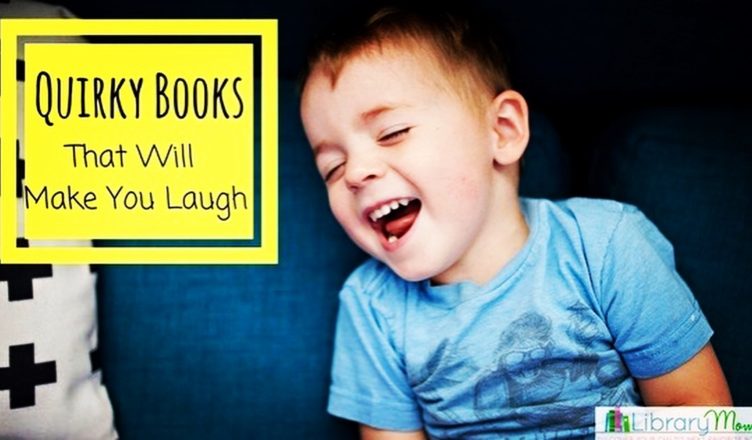





Love your posts LibraryMom! They’re always informative and provide lots of reading recommendations for parents and teachers alike!